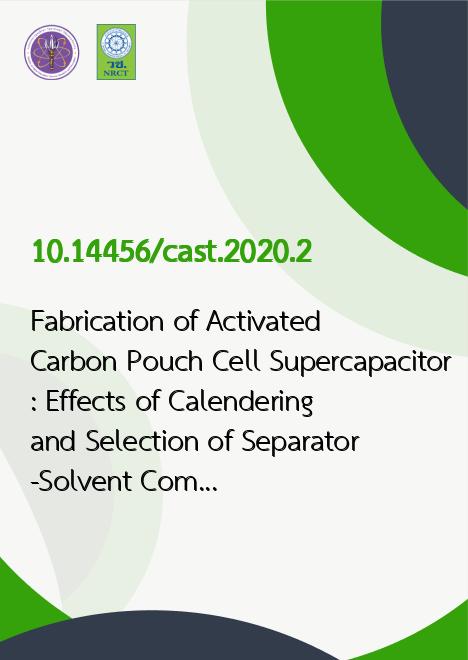
|
Fabrication of Activated Carbon Pouch Cell Supercapacitor: Effects of Calendering and Selection of Separator-Solvent Combination |
|---|---|
| รหัสดีโอไอ | |
| Creator | Jedsada Manyam |
| Title | Fabrication of Activated Carbon Pouch Cell Supercapacitor: Effects of Calendering and Selection of Separator-Solvent Combination |
| Contributor | Gladis Aros Safitri, Khanin Nueangnoraj, Paiboon Sreearunotha |
| Publisher | King Mongkut's Institute of Technology Ladkrabang |
| Publication Year | 2563 |
| Journal Title | Current Applied Science and Technology |
| Journal Vol. | 20 |
| Journal No. | 1 |
| Page no. | 124-135 |
| Keyword | supercapacitor, pouch cell, electric double-layer capacitor (EDLC), activated carbon, organic electrolyte |
| URL Website | https://www.tci-thaijo.org/index.php/cast |
| Website title | https://www.tci-thaijo.org/index.php |
| ISSN | 2586-9396 |
| Abstract | Most published articles reported characterization of a supercapacitor utilizing a coin cell or a Swagelok cell design, while the higher capacity format such as a pouch or cylindrical cell is needed to predict the performance of a supercapacitor for a practical application. In this work, the guideline to produce a pouch cell supercapacitor is given. The three-component electrode is based on a commercially available activated carbon, carbon black, and a polyvinylidene fluoride binder, which is formed a layer on a conductive-carbon coated aluminum foil current collector. The roles and optimization of a calendering process and selection of a separator-solvent combination are highlighted. The symmetric electric double-layer capacitor (EDLC) pouch cell using organic salt electrolyte is rated at 2.5 Volt. The pouch cell has the maximum capacitance of 32.6 F with a specific capacitance of 25.6-29.4 F/g. |